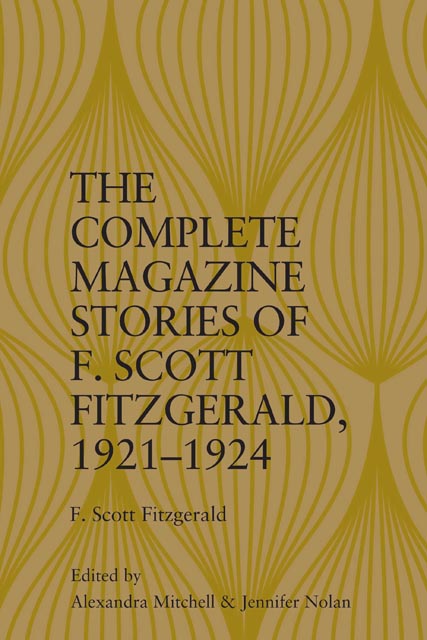Book contents
- Frontmatter
- Contents
- List of Figures
- Acknowledgments
- Introduction
- Stories
- Explanatory Notes, by Alexandra Mitchell
- Appendix 1 Ngram Language Analysis, by Alexandra Mitchell
- Appendix 2 Magazine Publication Details, by Jennifer Nolan
- Appendix 3 Visual Contexts of Fitzgerald’s Magazine Market, Images introduced and compiled by Jennifer Nolan
- Works Cited
Introduction
Published online by Cambridge University Press: 18 November 2023
- Frontmatter
- Contents
- List of Figures
- Acknowledgments
- Introduction
- Stories
- Explanatory Notes, by Alexandra Mitchell
- Appendix 1 Ngram Language Analysis, by Alexandra Mitchell
- Appendix 2 Magazine Publication Details, by Jennifer Nolan
- Appendix 3 Visual Contexts of Fitzgerald’s Magazine Market, Images introduced and compiled by Jennifer Nolan
- Works Cited
Summary
On the eve of the period that this volume addresses (1921–1924), F. Scott Fitzgerald was largely taking a break from writing short stories for the magazines after his initial spectacular success earlier in the year. As he would tell his literary agent Harold Ober in a letter dated 6 August 1920, Carl “Hovey, of the Metropolitan wrote me asking for more short stories but I’m embarked on my new novel now and tremendously interested.” Given the contract Fitzgerald had signed with Metropolitan for six stories in May, the first of which (“The Jelly-Bean”) he had promptly written that very month, Hovey's inquiry was understandable, and indeed the only story Fitzgerald would write and submit between August 1920 and August 1921 was “His Russet Witch,” the second story published by Metropolitan under this contract, which appeared in the February 1921 issue.
Yet while Fitzgerald's focus was on writing his second novel, the magazines were not far from his mind. From its outset in July 1920, the novel he had “embarked on,” The Beautiful and Damned, was framed as a serial for Metropolitan, as revealed in letters sent that month to both Ober and his editor at Scribner’s, Maxwell Perkins, and on 12 August 1920 Fitzgerald sent a detailed reply to Hovey about how to navigate the publication of the serial and the stories Hovey had requested. Also revealingly, as Kirk Curnutt explores, writing stories for the magazines shows up as “an unlikely plot twist” in The Beautiful and Damned, with the protagonist Anthony's unsuccessful attempt to “earn a fast buck writing popular fiction.” While ultimately Anthony proves unsuccessful due to his lack of dedication and ability, suggesting that such endeavors require some skill, there is still a hint of derision in Fitzgerald's description of the popular formula, and Curnutt argues that Fitzgerald's depiction of Anthony's processes demonstrate his own conflicted feelings: “‘He offered, in his protagonists, the customary denizens of the pink-and-blue literary world, immersing them in a saccharine plot that would offend not a single stomach in Marietta.’” Fitzgerald's satirical sketch, “This is a Magazine,” which appeared in the December 1920 issue of Vanity Fair, likewise lampoons the “vast and soggy interior of a magazine” with all of its awkwardly juxtaposed stories and surrounding materials, like advertisements and political articles.
- Type
- Chapter
- Information
- The Complete Magazine Stories of F. Scott Fitzgerald, 1921-1924 , pp. xi - xxxivPublisher: Edinburgh University PressPrint publication year: 2023



